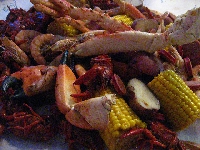
Learn how to do a seafood boil at home for a traditional free-for-all
A seafood boil is a festivity in which you and your guests tear through tons of shellfish, boiled in their shells, with your bare hands and a few useful tools to help you get at the meat. This is not for the faint of heart. But if you’re feeling adventurous and have always wanted to try to do your own seafood boil, this is how it’s done.
Select Your Location
Make no mistake; this is going to be a mess. A big beautiful mess, and, because of the visceral nature of the event, you wouldn’t want it any other way.
Therefore, making sure you have a good place to eat all this shellfish outside is a good . . . nay, an essential . . . part of your plan. It would follow, then, to make sure you’ve got your boil planned on a day with nice weather, and to set up tables in your back yard or on the porch.
Believe me, you don’t want to deal with cleanup from this kind of culinary barbarism in your formal dining room.
Gather Your Supplies
You are going to need these main things: A good seafood boil recipe; a big stock pot; Old Bay Seasoning (ask anyone, you can’t do this without it!); mallets, nutcrackers, and other implements of destruction; a goodly amount of newspaper or butcher paper (enough to cover the table on which you’re serving the food); and seafood.
~
The seafood you choose is largely up to your own preferences and what is fresh and readily available. Standard fare is crabs, shrimp, crawdads (or crawfish), lobster, and any kind of muscle, including clams and oysters. Basically, if it’s a shellfish you can purchase whole and in-shell, you can throw it in the pot.
If you live in a coastal region, it’s best to get most of your seafood live and boil it . . . yes . . . alive. It may seem brutal, but the crabs and what-not die fast, and you will have the absolute freshest seafood at your table.
Get to Cooking
If you’ve got your ingredients nailed down and your recipe chosen, go ahead and get started. If you want sides with your seafood boil, it might be nice to ask your guests to bring something. You don’t want to take away from the eating-with-our-fingers motif of the whole shindig, so suggest sides that can be eaten that way.
Some good crusty bread and corn-on-the-cob would be suitable. You don’t want to get too elaborate in this area, since the crustaceans you have so painstakingly selected and then sent to their deaths should really be the star of the show.
Prepare the Sacrificial Space
Here is the time honored tradition, and yes, the trick to doing a seafood boil without a ton of cleanup: cover your table with all that newspaper, butcher paper, or cut open brown paper bags.
You will be using no plates. There might be napkins, if you want to be that civilized. So make sure you lay down enough paper to soak up any seafood juices or errant drips of butter and sauces.
Then, set your table with mallets and nutcrackers and your aforementioned various implements of destruction, enough for your guests not to have to fight over who gets to use the lobster claw crackers next. Lay out your sauces, your sides, and your extra Old Bay seasoning for those who are so inclined. Finally, once everyone is seated and the seafood is all cooked and drained, bring it out and dramatically pour it in the center of the table, directly onto the paper.
At this point, you should have a feeding frenzy like you have never before seen in your humble abode. Shells will crack, claws will go flying, bits of crab meat will end up in your hair, and everyone will have a good old time.
When it’s all over?when your guests have had their fill and everyone has quit snarling at each other over the juiciest bits and making those unnerving guttural sounds?simply pull up all that paper, wrapping your dinner’s inedible remains within it, and throw it in the trash. All you have now is one pot and maybe some shell-cracking utensils to wash.
This is how it’s done.

